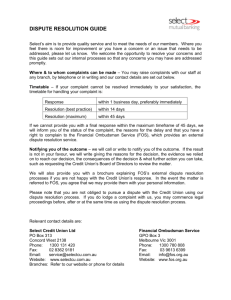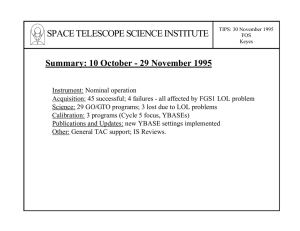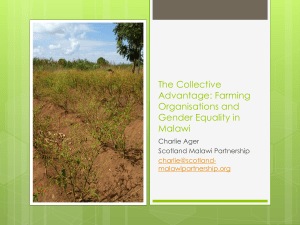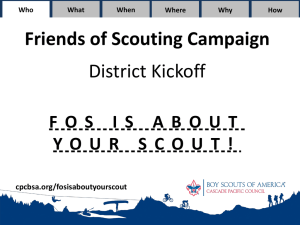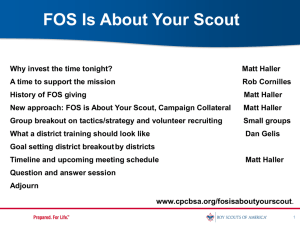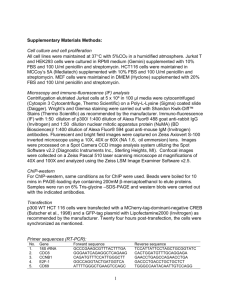SPACE TELESCOPE SCIENCE INSTITUTE Summary: 17 August - 9 October 1995
advertisement
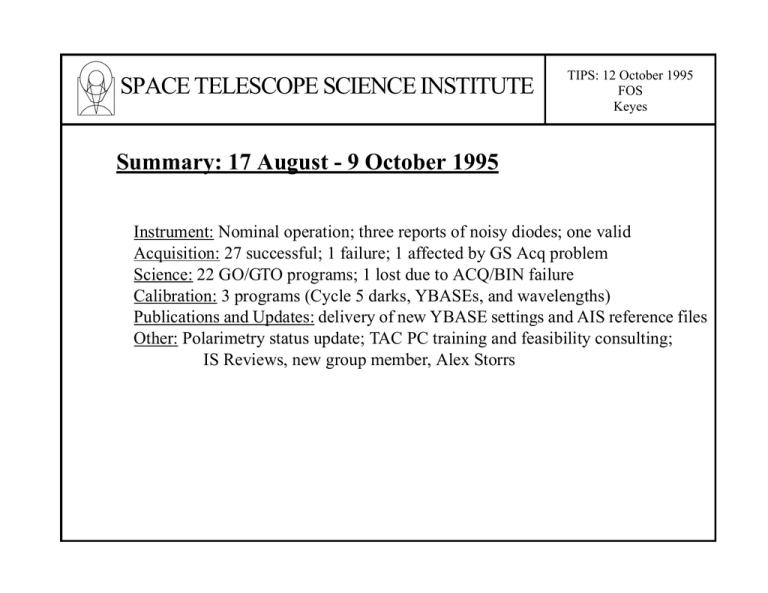
SPACE TELESCOPE SCIENCE INSTITUTE TIPS: 12 October 1995 FOS Keyes Summary: 17 August - 9 October 1995 Instrument: Nominal operation; three reports of noisy diodes; one valid Acquisition: 27 successful; 1 failure; 1 affected by GS Acq problem Science: 22 GO/GTO programs; 1 lost due to ACQ/BIN failure Calibration: 3 programs (Cycle 5 darks, YBASEs, and wavelengths) Publications and Updates: delivery of new YBASE settings and AIS reference files Other: Polarimetry status update; TAC PC training and feasibility consulting; IS Reviews, new group member, Alex Storrs SPACE TELESCOPE SCIENCE INSTITUTE TIPS: 12 October 1995 FOS Keyes Instrument Status (17 August - 9 October 1995): FOS instrumental operation mostly nominal Diodes: - three first-time noisy diodes reported; one added to “watch list” - FOS/BL diode 22 : GOs alerted; modify CALFOS scattered-light algorithm - FOS/BL diode 138 - reported by GO, resolved as noisy data - FOS/BL diode 148 - reported by OPUS, resolved as background Target Acquisitions: - one failed to single star guiding; 0.14 arcsec drift - one ACQ/BIN failed due to incorrectly specified target brightness and target coordinates. SPACE TELESCOPE SCIENCE INSTITUTE TIPS: 12 October 1995 FOS Keyes Publications/CDBS/PDB Updates (since 17 August 1995): New YBASEs delivered - effective 16 October 1995 includes all detector/disperser combinations and supported polarimetric modes; routine periodic update - normal trending continues. Initial Average-Inverse-Sensitivity (AIS) Method reference files and supporting tables delivered - effective after pipeline verification Other: Instrument status change for polarimetry. Training session for TAC Panel Coordinators - training document available. Feasibility review consulting ongoing with TAC PCs. HST Data Handbook revision continues. New FOS Instrument Scientist, Alex Storrs (410) 338-4903, storrs@stsci.edu SPACE TELESCOPE SCIENCE INSTITUTE TIPS: 12 October 1995 FOS Keyes AIS Flux Calibration Method : - establishes pipeline and STSDAS flux-calibration method accurate to <3% (with properly centered observations) - uses Bohlin absolute flux calibration standard system - system described in ISR CAL/FOS-144 (Bohlin, Lindler, & Keyes) and in “Spectrophotometric Standards from the Far-UV to the Near-IR on the White Dwarf Scale,” Bohlin, submitted to A.J. - starts with “average” 4.3 aperture sensitivity for each detector/disperser - included in AIS reference file (science header keyword AISHFILE) - accounts for aperture throughput as function of wavelength - included in CCSB reference table - accounts for time-dependence of sensitivity at each wavelength - included in CCSD reference table - for the pre-COSTAR case, tracks focus change history and accounts for its impact on aperture throughput - included in CCSA and CCSC reference tables, respectively. SPACE TELESCOPE SCIENCE INSTITUTE TIPS: 12 October 1995 FOS Keyes Polarimetry Status Changes: - FOS Cycle 6 Instrument Handbook advised usage of FOS/RD for polarimetry - Preliminary analysis of FOS/RD calibration indicated limiting accuracy for linear polarization of 1-1.5% - FOS/BL has limiting accuracy of 0.7% (and a goal of 0.2% through further calibration seems achievable) - effective 1 September, recommended to all proposers/users to switch to FOS/BL for all high-precision polarimetric observatons - all current PIs and the FOS STAN mailing list were notified - full description of status change placed on FOS WWW page. - all current un-executed FOS polarimetry programs changed without significant science impact (2 FOS/RD programs had already executed) - detailed FOS/RD calibration analysis continuing SPACE TELESCOPE SCIENCE INSTITUTE TIPS: 12 October 1995 FOS Keyes Panel Coordinator FOS Feasibility Training Summary: - described major aspects of FOS program feasibility review - summary “cookbook” document is available from FOS group - indicates major problem areas when an IS should ALWAYS be called - appropriate to Phase I and Phase II reviews - includes summary checklist - describes bright object evaluation - target acquisition analysis - includes requirements as function of specific science goals - comparison of FOS/BL and GHRS G140L capabilities - brief description of instrument and important operating modes - contains certain features specific to Phase I (e.g., orbit budgeting evaluation) SPACE TELESCOPE SCIENCE INSTITUTE TIPS: 12 October 1995 FOS Keyes The SSD FOS Group Name Title Telephone Group Lead (410) 338-4975 keyes@stsci.edu Anuradha Koratkar Instrument Scientist (410) 338-4470 koratkar@stsci.edu Michael Dahlem Instrument Scientist (410) 338-4733 dahlem@stsci.edu Jeffrey Hayes Instrument Scientist (410) 338-4936 hayes@stsci.edu Alex Storrs Instrument Scientist (410) 338-4903 storrs@stsci.edu Jennifer Christensen Data Analyst (410) 338-1265 christen@stsci.edu Stephan Martin Data Analyst (410) 338-4724 smartin@stsci.edu Charles (Tony) Keyes e-mail
